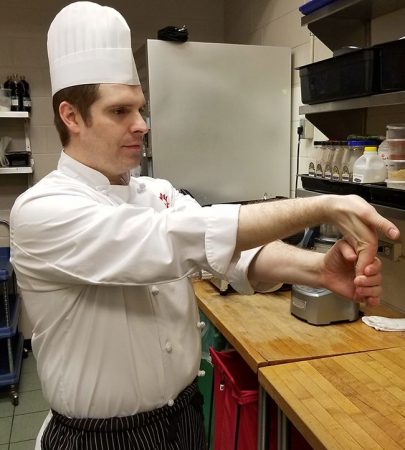
Stretching from prep to pie
By Chris Semenuk Registered Massage Therapist
Features Business and Operations Staffing chris semenuk health health and safety massage therapy registered massage therapist repetitive strain stretching exerciseHow to stretch properly to reduce work-related aches and pains
 Hold your arm out straight in front of you, bend your wrist with your fingers pointing downwards and with the opposite hand pull back on the hand of the arm you are stretching. Photos by Chris Semenuk, RMT
Hold your arm out straight in front of you, bend your wrist with your fingers pointing downwards and with the opposite hand pull back on the hand of the arm you are stretching. Photos by Chris Semenuk, RMTIn my experience as a registered massage therapist (RMT), I have seen many people with aches and pains from all walks of life, particularly those with highly physically demanding jobs. Many of these pains can be preventable with just a little bit of time dedicated to preparing the body for the tasks it is about to do.
Stretching is important, which probably comes as no surprise. What is a surprise is that many seem to “get it wrong” when getting themselves ready to work. This article will explain how to stretch properly and how stretches will help you reduce work-related aches and pains.
STRETCHING 101
There are two basic types of stretches. Static stretching is when you hold a position for a set period of time, while dynamic stretching is when you continue to move through a stretch. Dynamic stretching has been shown to have the greatest benefit for avoiding aches and pains, but it is suggested to use both together.
STATIC STRETCHES
Static stretches need to be held for only 20 seconds to accomplish their goals. I would suggest doing two to three sets of 20-second holds, stretching the muscle groups that tend to give you the most hassle at the end of the day. When holding, try to stretch the muscle so that you can feel the stretch, but not to the point where it feels painful. A painful stretch can actually have a negative effect, causing you to tighten up as your body tries to fight being over-stretched.
Try stretching the forearm muscles prior to any specific work such as knife use, kneading of dough, carrying heavy containers or other similar tasks. Hold your arm out straight in front of you, bend your wrist with your fingers pointing downwards and with the opposite hand pull back on the hand of the arm you are stretching. You should feel this stretch in the muscles on the top of your arm. Hold this for the 20 seconds, and then bend your wrist the other way with your fingers upwards and pull the hand back towards you again. Repeat this twice and then change arms. That is all there is to it!
DYNAMIC STRETCHES
Dynamic stretches are used to mimic the task you are about to do, but without the resistance or weight of the real task. This gets your muscles used to the movement and builds up tolerance for the bigger task of actually moving items and using equipment.
If your hands and arms will be moving all over the place to knead dough, grab and twist a ladle, and throw toppings on the pie, then making circles with the shoulder, elbow, and wrist joints will be beneficial. These circles can be done all in one movement, and without any equipment or resistance. Just wave them about in the air in front of yourself for 30 seconds. The circles can get gradually larger as you progress through the 30 seconds. The goal is to get to a range that is larger than the range you will be using for the task. If you work in an area that requires you to move your shoulder 45 degrees to each side, then do the circles to 60 degrees or more. This will make it easier for your body to get to that 45-degree mark when you’re actually doing the task. This movement will prepare your muscles and joints so that you feel fewer aches and pains when you’re done.
This type of movement can be done for any of your muscles and joints. For example, if you are going to be lifting and moving big boxes or containers, you should get your knees and back ready for the lift. Go from standing straight, to bending the knees to standing straight again for 30 seconds. Try and bend more each time, getting closer and closer to the floor to get those joints ready to lift heavy items.
At periods throughout your shift, and especially when getting back from a break, repeat the key stretches for what you will be doing. Going through the ranges that go beyond your working zone will help even more to prevent the aches at the end of the shift.
PAIN RELIEF
If you’re feeling muscle and joint soreness, applying heat can help relieve some pain. If using something like a beanbag or heating pad that covers a specific area, 10 minutes of heat should be enough to accomplish things. But if you’re having a hot shower, then let the water run over the sore area for about 20 minutes.
Massage therapy can help get to the areas and the deeper parts of the muscles that you just can’t do yourself. It can help increase strength, improve function and reduce pain. Don’t try and work through the pain, as that will make things worse.
Your body will tell you when it needs help. Don’t ignore it: it knows what it is talking about.
A massage therapist in London and St. Thomas, Ont., for 17 years, Chris Semenuk, RMT, has been involved in the profession as a professor, program creator, Pan-Am lead medical professional, and head RMT for Western University track and field and cross-country. Prior to this Chris was an internationally competitive track athlete and an 11-year grocery store employee. For more information, visit lifemark.ca/Wortley-Village (London) or lifemark.ca/5th-And-Dunkirk (St. Thomas).
Print this page





